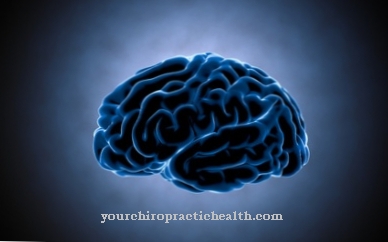At the Radius periosteal reflex it is a self-reflex of the human body. Normally, a blow to the arm causes the forearm to bend slightly; if the reflex is absent, this may indicate a neurological or muscular disorder.
What is the radius periosteal reflex?

The radius periosteal reflex or Brachioradialis reflex is a self-reflex of the arm. Medicine calls a reflex self-reflex when irritation and reaction take place in the same organ. The radius periosteal reflex is triggered by a blow on the radius. The radius is a bone in the forearm, also known as the spoke.
The radius is what is known as a tubular bone: the inside of the marrow cavity of the bone forms a uniform tube in which the bone marrow is located. Together with the ulna (ulna), the radius forms the skeleton of the forearm.
In order to trigger the radius periosteal reflex, the forearm must be bent to the upper arm. It must not be turned outwards or inwards. Medicine calls an outwardly turned position suspination, while the inwardly turned position of the forearm is called pronation. A blow to the radius triggers the radius periosteal reflex and consequently pronation of the hand and forearm.
Function & task
The radius periosteal reflex is based on a simple neurological circuit. Receptors on the forearm register the blow against the bone: The mechanical stimulation causes the sensory nerve cell to fire, i.e. to produce a signal. It does this by changing the electrical charge on the neuron.
Changes in the cell membrane shift the ion ratio between the inside and outside of the cell and the neuron depolarizes. The neuron forwards the stimulation via its axon as a summed electrical potential. At the end of the nerve cell there is an interface between the first and a second cell. The natural sciences refer to this interface as the synaptic gap. The signal passes through the synaptic gap by first being translated into a chemical form: the electrical voltage of the first nerve cell causes the release of neurotransmitters. Neurotransmitters are messenger substances that enter the synaptic cleft and reach the second nerve cell at the other end. There the neurotransmitters bind to specialized receptors, to which they fit like a key in a lock. The occupied receptors now also trigger a change in the electrical charge in the second nerve cell by opening ion channels in the cell membrane: The second nerve cell depolarizes and the information about the stimulation has successfully passed to the second neuron.
In the case of the radial periosteal reflex, this connection is monosynaptic: only a single synapse is involved in the transmission of the signal from the receptor to the spinal cord. Biology also describes this forwarding of signals as afference, from the Latin word for “carry along” (“affere”). On the opposite path, the efferent (“carrying out”) nerve path, the motor neuron then sends the signal to muscle contraction. This signal is directed to the upper arm muscle (brachioradialis muscle). The upper arm spoke muscle is a skeletal muscle that is located in the upper arm and faces the side facing the thumb. By contracting the upper arm spoke muscle, the corresponding tendon is shortened and the forearm flexes.
Neurology designates the nerve tracts that are responsible for the radial periosteal reflex with the numbers C4 and C6. In addition, the radial nerve also participates in the neuronal transmission of information. Like all self-reflexes, the radius periosteal reflex takes place without involvement of the brain; therefore, humans cannot consciously control, suppress or voluntarily trigger it.
Illnesses & ailments
When checking the radius periosteal reflex, doctors compare whether the reaction is the same on both sides.This comparison minimizes misdiagnosis, as the examination can take into account inter-individual differences with regard to the ability to react.
The absence of the radial periosteal reflex may indicate radial paralysis. This is a paralysis of the arm that affects the wrist and finger extensors. This is due to damage to the nerves of the upper arm, especially the radial nerve. Radial paralysis manifests itself in a characteristic finger position: the relatively high muscle tension slightly flexes the muscles of the fingers and the wrist, giving the impression that the person concerned is trying to point to something or hold out his hand to kiss. For this reason, the vernacular also calls this posture kiss or drop hand.
Radial paralysis is often caused by a fracture of the upper arm or some other severe mechanical impact. It can also arise, for example, when the person concerned lies motionless on their side for a long time, as is the case with anesthesia or with bedridden patients. In this case, the body weight presses on the radial nerve for a long period of time, possibly causing damage. The therapy for radial palsy depends on the causes in each individual case; the damaged nerve can be reconstructed under certain circumstances or regenerate itself with sufficient rest.
The lack of the radial periosteal reflex is also potentially a symptom of myotonic disease. This is a group of different muscle diseases that are characterized by prolonged muscle tension and delayed relaxation. This group includes various syndromes of muscle wasting. Myotonic dystrophy type 1, for example, is a genetic disease that manifests itself through muscle weakness, cardiac arrhythmia and hormonal abnormalities. With her and similar diseases, the main focus is on treating the symptoms.


.jpg)





.jpg)



















